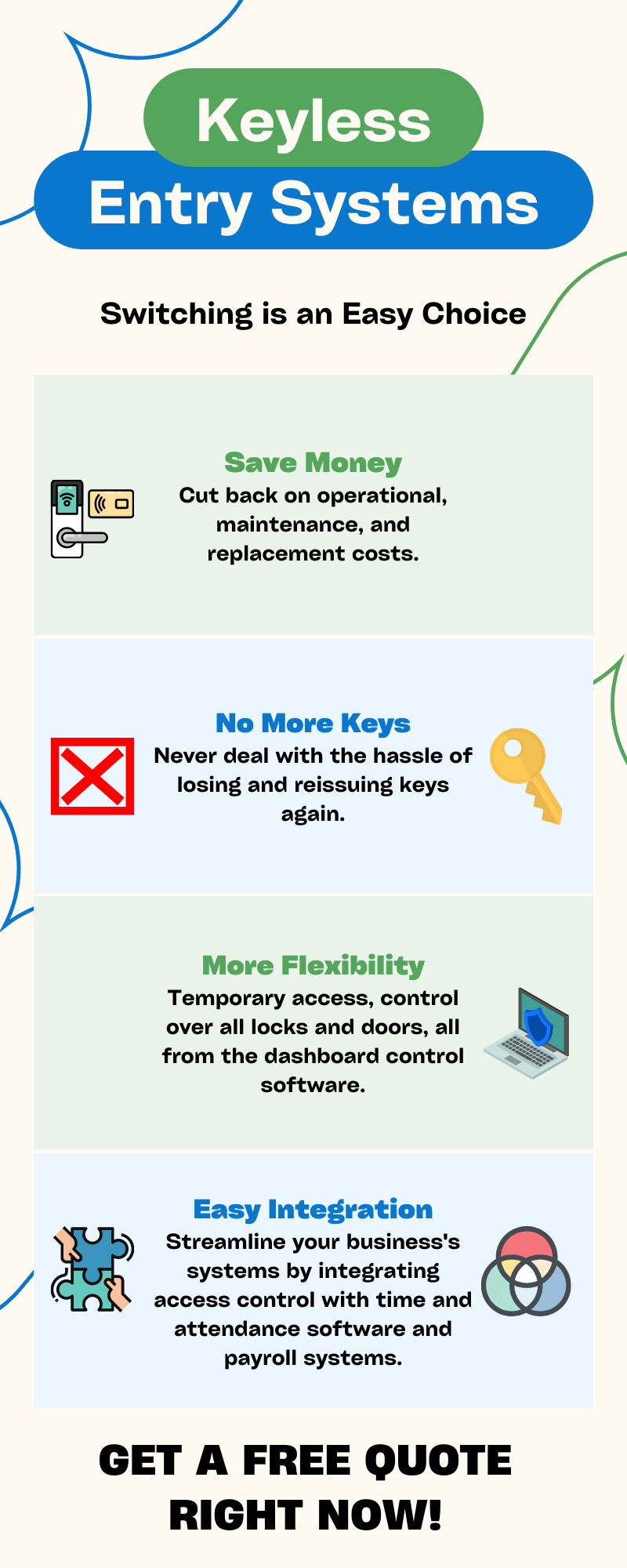All types of businesses today are looking for ways to better their business security systems. And this starts with using a great access control system and ensuring access control best practices. Nowadays, businesses no longer need to issue bulky sets of keys to employees, staff, and other authorized personnel. They can conveniently use keyless entry systems, which provide a customized and seamless experience for access control needs.
Related: Best 5 Cloud-Based Access Control Systems in 2021

What is a Keyless Entry System for Businesses?
Generally speaking, a keyless entry system for business is a digital access control system that does not require a traditional lock and key entry method. Business owners no longer need to make keys for each new employee they hire, not to mention worry about employees losing keys or sharing them with unauthorized persons. They can simply install a keyless door access control system and choose how they prefer their employees to enter the property.
Thanks to better technology and security, keyless entry systems help business remain more secure and tech-savvy. Because they are synced with back-end software, they provide more oversight and access control data so businesses can improve their physical security. Additionally, they provide a more convenient entry method for employees, since they no longer have to carry keys around.
There’s a ton of additional added benefits to using keyless entry systems, which we will touch on later.
Types of Keyless Entry Systems
By definition, a keyless entry system simply does not require a physical set of keys. There are many different ways a business can implement a keyless entry system. Types of keyless entry systems range from totally virtual, hands-free methods such as mobile authentication, to simpler versions of keys such as ID cards and key fobs.
Keep in mind that certain types of keyless entry systems are touch-free while others require touch for access. For instance, biometric fingerprint authentication is keyless but is not touch-free. You may want to keep this in consideration during Covid-19 precautions.
Let’s explore the different options when it comes to keyless entry systems for businesses.
Keyless authentication methods
- ID cards and badges: Your business can print off ID cards or employee badges for new employees. The employee presents the ID card to a proximity reader or magnetic stripe reader when arriving.
- Biometric readers: Biometric readers help you avoid keys by requiring a fingerprint, palm print, etc. when employees enter. New employees record their biometric data when hired, and simply “scan in” when entering.
- Key fobs: Key fobs are small, lightweight electronic keys that can be easily attached to a keychain. They tend to be more seamless and convenient than a traditional set of keys. Plus, they can be programmed to open multiple doors using back-end access control software.
- Keypad: A keypad is usually attached to a smart lock on a door. Users will simply type in the correct password to digitally unlatch the lock.
- Mobile apps or Bluetooth: Many businesses today are using mobile apps as access control methods. This can be convenient because it’s a touch-free, portable system, and most employees today have access to a smartphone. Employees simply use their mobile app to digitally unlock the door, which uses Bluetooth to detect the authentication signal.
- Interactive voice recognition (IVR): Some businesses may use a voice recognition system. To use IVR for access control, you can either install an intercom box or have employees record their voice using a telephone or mobile device.
Keyless door readers
- Proximity readers: Proximity readers are used for key fobs as well as some ID cards and mobile apps. Employees hold their digital key next to the reader to unlock the door.
- Magnetic stripe readers: These are used to read ID cards and badges that have magnetic stripes. Employees typically swipe their ID card through the card reader.
- Bluetooth readers: Bluetooth readers are used for mobile app authentication only. When the user unlocks the door using their mobile device, the Bluetooth reader will detect the signal to unlock the door.
- QR code or barcode readers: Some ID cards or mobile apps may use QR codes or barcodes for authentication. Users can hold their QR or barcode next to the reader for entry.
- Smart keypad lock: Smart locks often have an attached keypad where users can type in their password to enter. The digital lock is activated when correct passwords are entered.
How do Keyless Entry Systems Work?
Remember that keyless entry systems are digital access control solutions. The system will require either a stable Internet connection and/or batteries to run on a regular basis. You will have to spend some time installing the system digitally, as well as training with your employees, to understand how to use the system daily.
With that being said, different types of access control systems work in different ways depending on the specific door readers, authentication methods, software, and more.
Hardware and Software
To get started, here’s what your business will need to utilize a keyless entry system:
- Door reader: You will need to purchase and install hardware to each door where you want access control. The door reader will approve or deny access to each user when they present their keyless authentication method. Some door readers are electric and run using a battery, while others might require a WiFi network.
- Authentication methods: Decide which authentication method your business wants to use for the keyless entry system. If you are using physical methods, such as key fobs or ID cards, you will need to print and distribute these to each user. If you are using virtual methods, such as mobile apps, biometric readers, or IVR, you will need to set up this system and train employees on how to use it.
- Internet connectivity: For keyless entry systems to work, you will need to connect the system (including door readers if applicable and software) to your business’s internet. Make sure you have a stable WiFi network.
- Software: Use back-end software to monitor access control. You can change access control rules and restrictions, which users have access where, passwords, and more. You can also pull real time reports about access to each door or location.
Note that most access control suppliers will assist you with set-up and installation, and many offer training on using the keyless entry system as well.
Benefits of Keyless Entry Systems for Businesses
1. Touch-free, germ-free
Some keyless entry systems are touch-free, which means they are also germ-free. While not every keyless entry system option is going to be touch-free, there are plenty of systems available to businesses today if you want to avoid contamination and germs in the workplace. This is especially important for businesses returning to work in the age of Covid-19, but it can also be a health and safety precaution in the future.
2. No lost keys
Have you ever had an employee that lost their keys? You have to reissue keys when they are lost, not to mention worry about changing locks to avoid possible security breaches. If you choose a virtual and keyless access control system, you’ll never have to worry about lost keys or reissuing keys in this scenario.
3. Cost savings
There are many ways in which keyless entry systems can save businesses money. Firstly, keyless systems save your business money on operational costs, since one you won't have to print loads of keys for employees, not to mention separate keys for each door. Secondly, it saves you money on maintenance and replacement costs, as keyless systems aren't subject to loss as much as physical keys are. You will also save money as you boost data and security, as monitoring access control using a back-end software prevents theft and property loss, among others.
4. Allows temporary access
Many businesses need to be able to provide temporary access to certain users. A digital keyless entry system synced with software is the best way to do this. Using the software, managers can assign and reassign cards, mobile apps, and other authentication methods for new users.
This creates an easier turnover solution for businesses that frequently have users coming and going, such as hotels. Other businesses might have contractors or visitors coming during certain days, so they want to provide a seamless method for those people to enter the business in a secure way.
5. Remote access control restrictions
Keyless entry systems are integrated with back-end software where managers can control settings. Using a simple dashboard, managers can control which users have access to which doors and at what times. For instance, if a business or location closes at 5pm, they can program the system to lock all doors after closing hours.
Compare this to a traditional lock and key system, where keys can be used at any time regardless of hours. To this end, keyless entry systems provide a much more robust access control solution.
6. More data and security
Keyless entry systems with software provide much more access control data compared to traditional lock and key methods. Business owners can pull reports using the software about entry history, unauthorized access attempts, visitor attendance, and much more.
In terms of security, keyless access control ensures the correct users are entering the business while preventing unauthorized users from entering. Many software options also allow managers to set up notifications, alerting them of security breaches or other worrisome events. Compare this to physical keys, which can be easily shared or redistributed and fall into the wrong hands.
7. Integrations
Did you know that digital keyless entry systems can be integrated with additional back-end software and systems? In addition to access control software, keyless entry systems can also often be integrated with time and attendance tracking systems, such as biometric time readers, as well as payroll systems. This creates an all-in-one system for businesses to manage access control, employee hours, and payroll.
Learn more about the benefits of time and attendance systems.
Additional resources
If you are looking for a keyless entry system for your business, we consider looking into the following resources for your research:
- Top 10 Business Access Control Systems
- Top 5 Access Control System Manufacturers
- How Much Does a Business Security System Cost?
Are you ready to compare prices and options for keyless entry systems and access control systems? You can use our free online comparison tool here. We ask you just a few questions about your business and needs. Then, we match you with our top access control suppliers that are suited to you. It’s a win-win!

